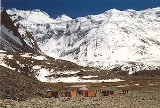
Ismail Samani Peak
Encyclopedia
Ismoil Somoni Peak is the highest mountain
in Tajikistan
and in the former Soviet Union
, named after Ismoil Somoni, the ancestor of the Samanid dynasty
.
When the existence of a peak in the Soviet Pamir Mountains
higher than Lenin Peak
was first established in 1928, the mountain was tentatively identified with Garmo Peak; but as the result of the work of further Soviet expeditions, it became clear by 1932 that they were not the same, and in 1933 the new peak, in the Akademiya Nauk Range
, was named Stalin Peak (Pik Stalina, пик Сталина), after Joseph Stalin
. In 1962, the name was changed to Communism Peak (Tajik
: Пики Коммунизм, Russian
: Pik Kommunizma, пик Коммуни́зма), and in 1998 to its current name.
The first ascent was made 9 September 1933 by the Soviet mountaineer
Yevgeniy Abalakov
.
There are glacier
s on Ismoil Somoni Peak.
Mountain
Image:Himalaya_annotated.jpg|thumb|right|The Himalayan mountain range with Mount Everestrect 58 14 160 49 Chomo Lonzorect 200 28 335 52 Makalurect 378 24 566 45 Mount Everestrect 188 581 920 656 Tibetan Plateaurect 250 406 340 427 Rong River...
in Tajikistan
Tajikistan
Tajikistan , officially the Republic of Tajikistan , is a mountainous landlocked country in Central Asia. Afghanistan borders it to the south, Uzbekistan to the west, Kyrgyzstan to the north, and China to the east....
and in the former Soviet Union
Soviet Union
The Soviet Union , officially the Union of Soviet Socialist Republics , was a constitutionally socialist state that existed in Eurasia between 1922 and 1991....
, named after Ismoil Somoni, the ancestor of the Samanid dynasty
Samanid
The Samani dynasty , also known as the Samanid Empire, or simply Samanids was a Persian state and empire in Central Asia and Greater Iran, named after its founder Saman Khuda, who converted to Sunni Islam despite being from Zoroastrian theocratic nobility...
.
When the existence of a peak in the Soviet Pamir Mountains
Pamir Mountains
The Pamir Mountains are a mountain range in Central Asia formed by the junction or knot of the Himalayas, Tian Shan, Karakoram, Kunlun, and Hindu Kush ranges. They are among the world’s highest mountains and since Victorian times they have been known as the "Roof of the World" a probable...
higher than Lenin Peak
Lenin Peak
Lenin Peak , rises to in Gorno-Badakhshan on the border of Tajikistan and Kyrgyzstan, and is the second-highest point of both countries. It is considered one of the easiest 7,000 m peaks in the world to climb and it has by far the most ascents of any 7,000 m or higher peak on earth, with every...
was first established in 1928, the mountain was tentatively identified with Garmo Peak; but as the result of the work of further Soviet expeditions, it became clear by 1932 that they were not the same, and in 1933 the new peak, in the Akademiya Nauk Range
Akademiya Nauk Range
Akademiya Nauk Range is a mountain range in the Western Pamirs of Tajikistan. It is stretched in the meridianal direction and considered to be the core of the Pamir mountain system....
, was named Stalin Peak (Pik Stalina, пик Сталина), after Joseph Stalin
Joseph Stalin
Joseph Vissarionovich Stalin was the Premier of the Soviet Union from 6 May 1941 to 5 March 1953. He was among the Bolshevik revolutionaries who brought about the October Revolution and had held the position of first General Secretary of the Communist Party of the Soviet Union's Central Committee...
. In 1962, the name was changed to Communism Peak (Tajik
Tajik language
Tajik, Tajik Persian, or Tajiki, is a variety of modern Persian spoken in Central Asia. Historically Tajiks called their language zabani farsī , meaning Persian language in English; the term zabani tajikī, or Tajik language, was introduced in the 20th century by the Soviets...
: Пики Коммунизм, Russian
Russian language
Russian is a Slavic language used primarily in Russia, Belarus, Uzbekistan, Kazakhstan, Tajikistan and Kyrgyzstan. It is an unofficial but widely spoken language in Ukraine, Moldova, Latvia, Turkmenistan and Estonia and, to a lesser extent, the other countries that were once constituent republics...
: Pik Kommunizma, пик Коммуни́зма), and in 1998 to its current name.
The first ascent was made 9 September 1933 by the Soviet mountaineer
Mountaineering
Mountaineering or mountain climbing is the sport, hobby or profession of hiking, skiing, and climbing mountains. While mountaineering began as attempts to reach the highest point of unclimbed mountains it has branched into specialisations that address different aspects of the mountain and consists...
Yevgeniy Abalakov
Yevgeniy Abalakov
Yevgeniy Mikhaylovich Abalakov was a Soviet alpinist and sculptor. He is noted for making the first ascent of the highest point of the Soviet Union - Stalin Peak on September 3, 1933 as a member of the 26th detachment of the Tajik-Pamir Sovnarkom expedition. At the beginning of the German-Soviet...
.
There are glacier
Glacier
A glacier is a large persistent body of ice that forms where the accumulation of snow exceeds its ablation over many years, often centuries. At least 0.1 km² in area and 50 m thick, but often much larger, a glacier slowly deforms and flows due to stresses induced by its weight...
s on Ismoil Somoni Peak.

